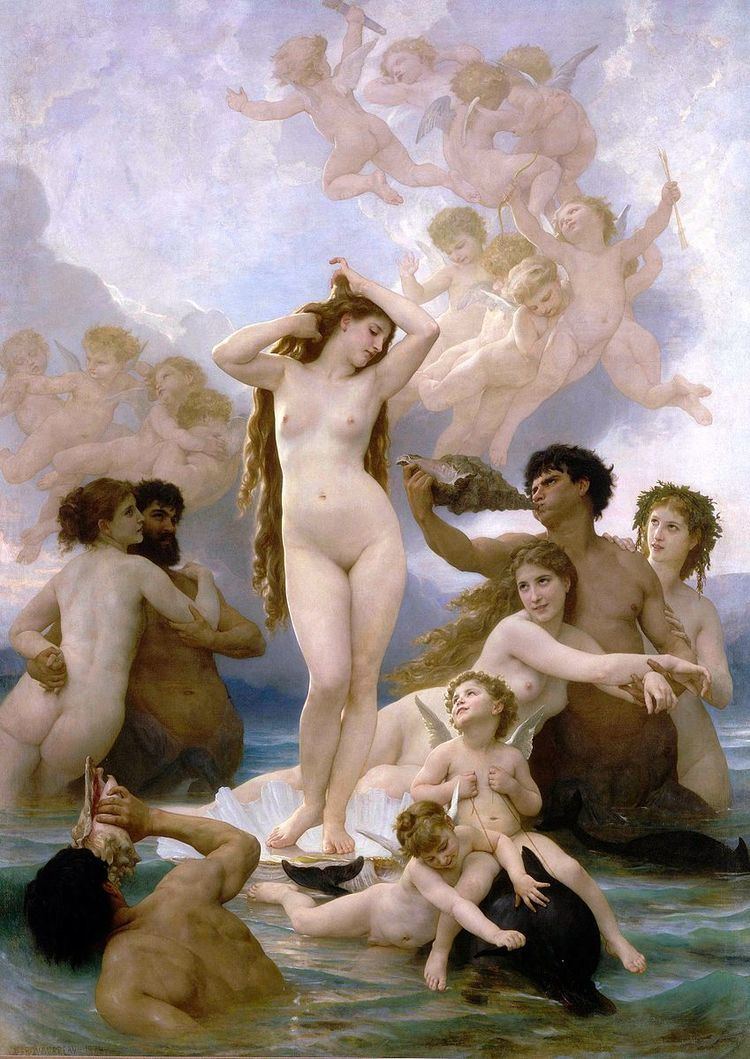Year 1879 (1879) Dimensions 3 m x 2.18 m Genre History painting Media Oil paint | Created 1879 | |
 | ||
Similar William-Adolphe Bouguereau artwork, Artwork at Musée d'Orsay, Oil paintings | ||
The birth of venus botticelli
The Birth of Venus (French: La Naissance de Vénus) is one of the most famous paintings by 19th-century painter William-Adolphe Bouguereau. It depicts not the actual birth of Venus from the sea, but her transportation in a shell as a fully mature woman from the sea to Paphos in Cyprus. She is considered the epitome of the Classical Greek and Roman ideal of the female form and beauty, on par with Venus de Milo.
Contents
- The birth of venus botticelli
- Artsleuth 3 botticelli the birth of venus final version uffizi gallery
- History
- Description
- References
For Bouguereau, it is considered a tour de force. The canvas stands at just over 9 ft 10 in (3.00 m) high, and 7 ft 2 in (2.18 m) wide. The subject matter, as well as the composition, resembles a previous rendition of this subject, Sandro Botticelli's The Birth of Venus, as well as Raphael's The Triumph of Galatea.
Artsleuth 3 botticelli the birth of venus final version uffizi gallery
History
The Birth of Venus was created for the Paris Salon of 1879. It was awarded the Grand Prix de Rome, and was purchased by the state for the Musée du Luxembourg. The painting is now in the permanent collection of the Musée d'Orsay in Paris.
Description
At the center of the painting, Venus stands nude on a scallop shell being pulled by a dolphin, one of her symbols. Fifteen putti, including Cupid and Psyche, and several nymphs and centaurs have gathered to witness Venus' arrival. Most of the figures are gazing at her, and two of the centaurs are blowing into conch and Triton shells, signaling her arrival.
Venus is considered to be the embodiment of feminine beauty and form, and these traits are shown in the painting. Her head is tilted to one side, and her facial expression is calm, comfortable with her nudity. She raises her arms, arranging her thigh-length, brown hair, swaying elegantly in an "S" curve contrapposto, emphasizing the curves of her body.
The model for Venus was Marie Georgine, princess of Ligne. In 1861, she was on a short holiday in Paris with her lover. Together, they modeled for Bouguereau's "Abduction of Psyche" and "Flora and Zephyr". He worked out Venus and other sketches and paintings later from photographs he took of the couple. Some of Bouguereau's other works, like La Nuit, are also based on her. Marie was also painted by Léon Bonnat and photographed by Antoine Samuel Adam-Salomon.
Venus' figure was enlarged from a nymph from Bouguereau's The Nymphaeum, completed in 1878, a year earlier. The nymph is slightly thinner, and her breasts are fuller and more rounded. Venus' contrapposto is more intense, and her hair is also longer and lighter than the nymph's, but she arranges it almost identically.
To the upper-left of the painting, there is a shadow in the clouds. It appears to be the silhouette of the artist, with a head, shoulder, arm, and a raised fist that would seem to hold a paintbrush.
